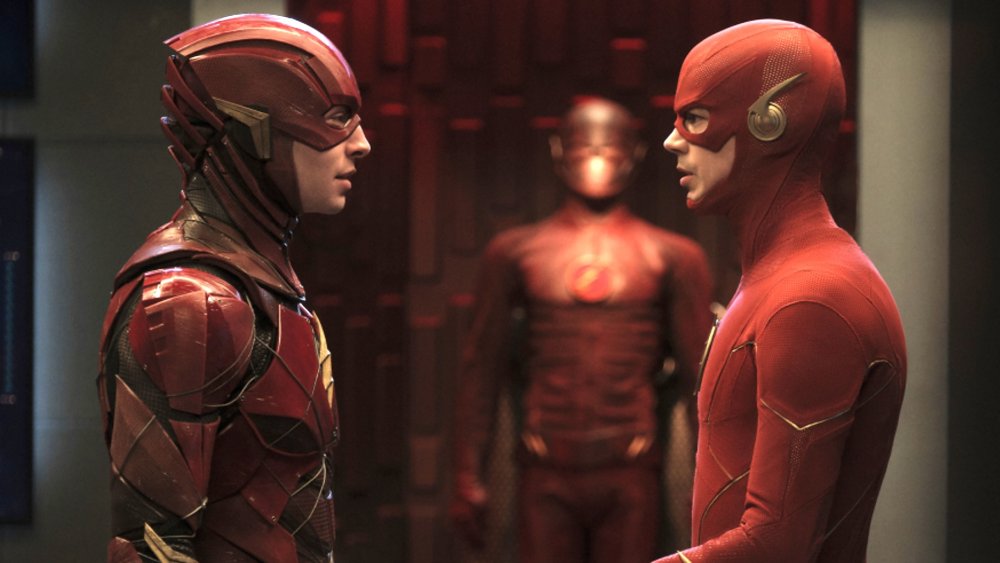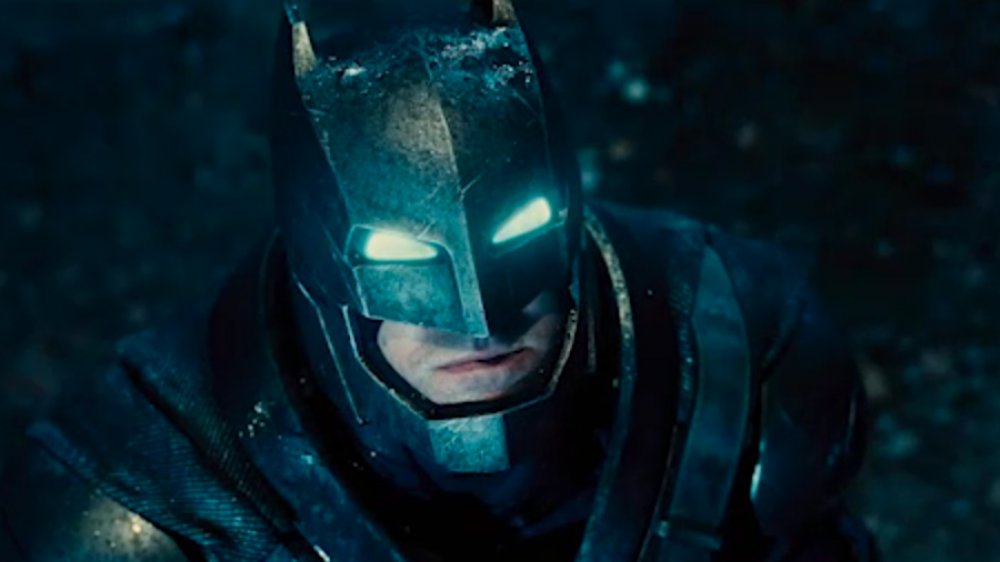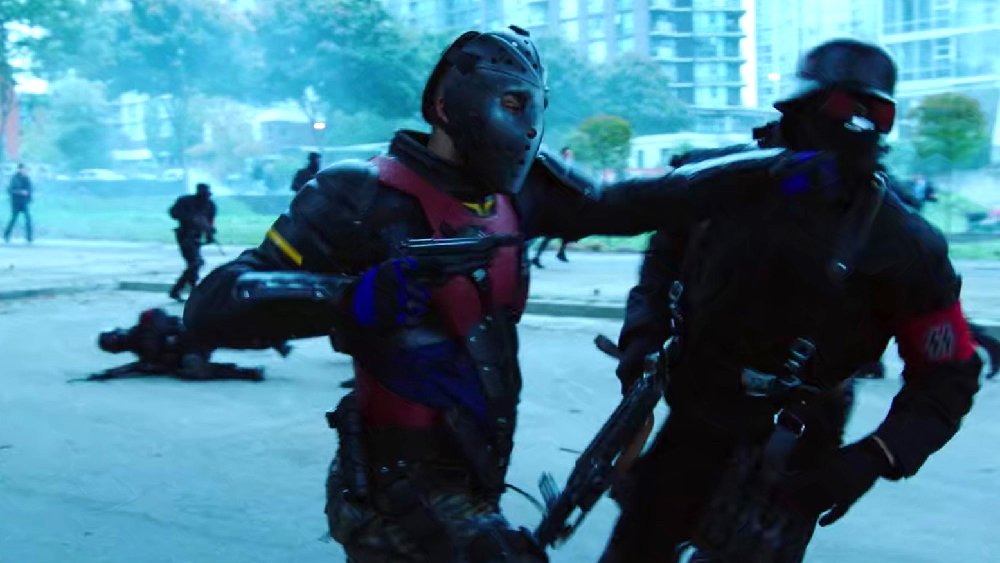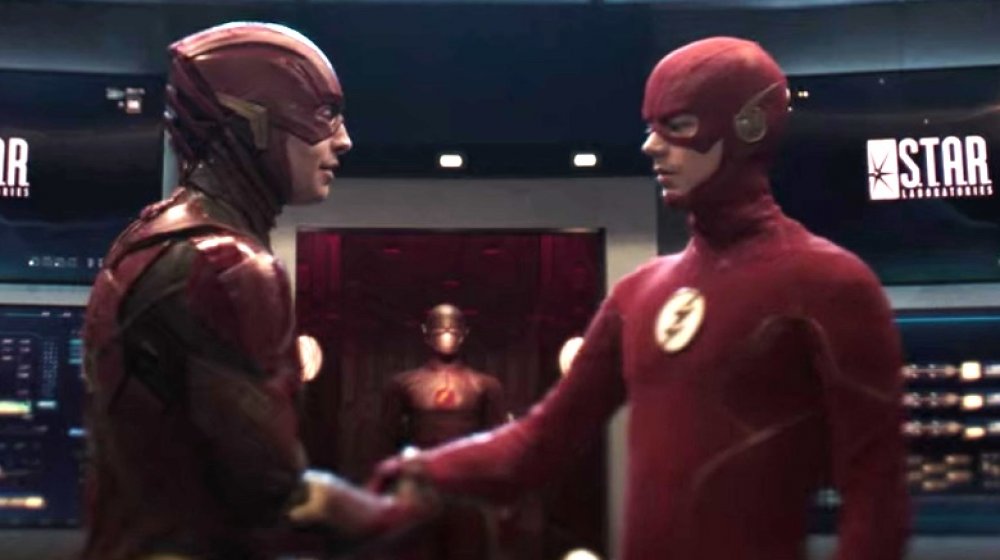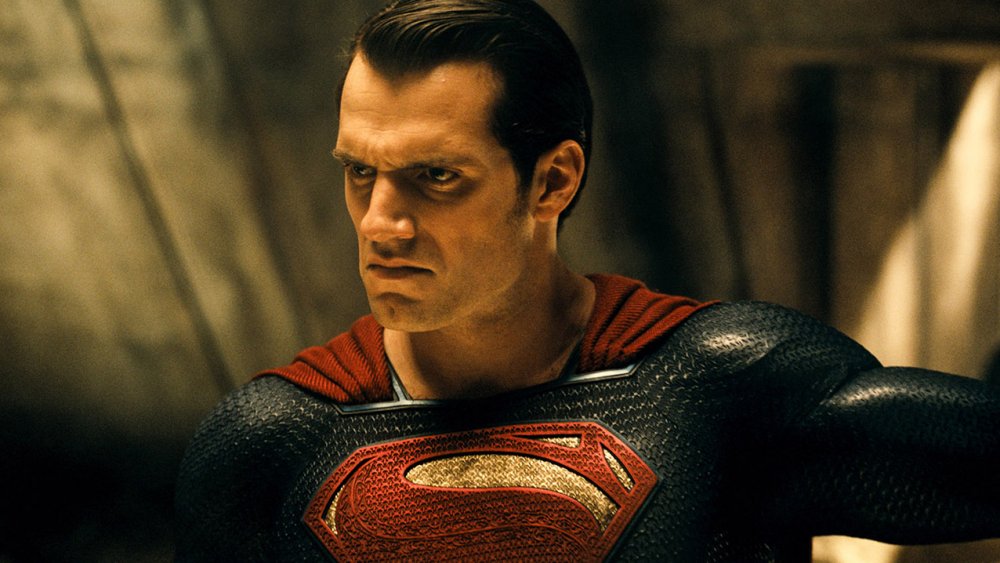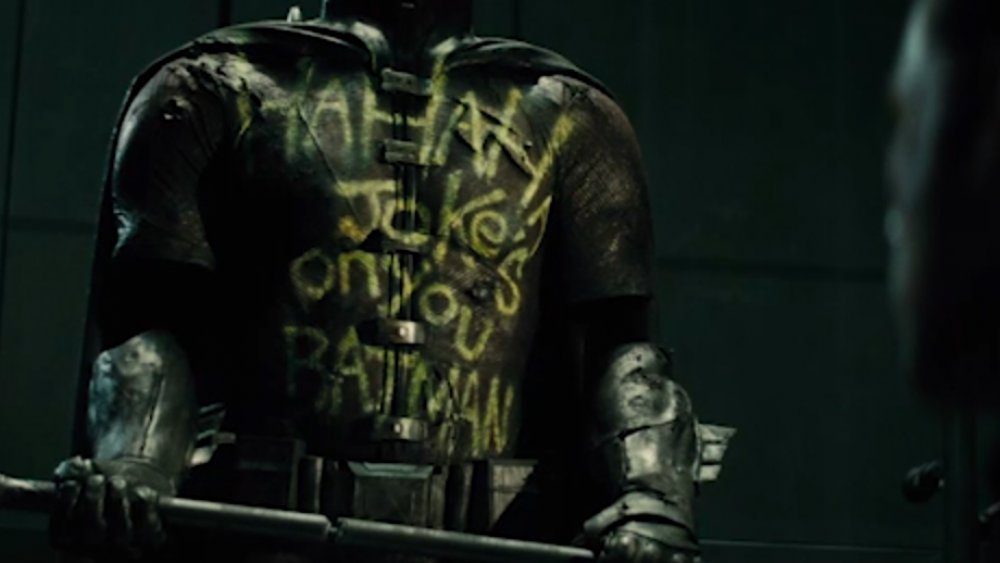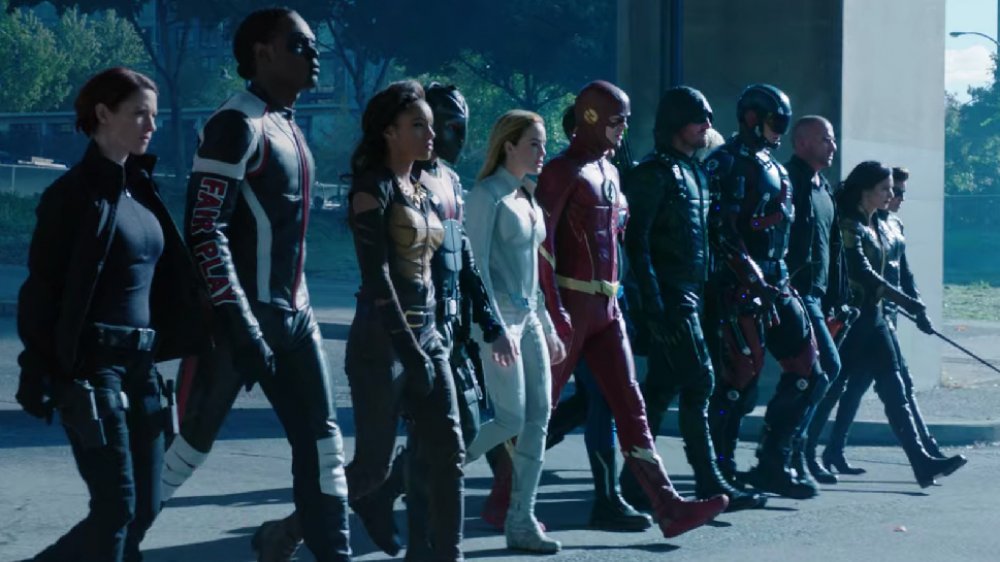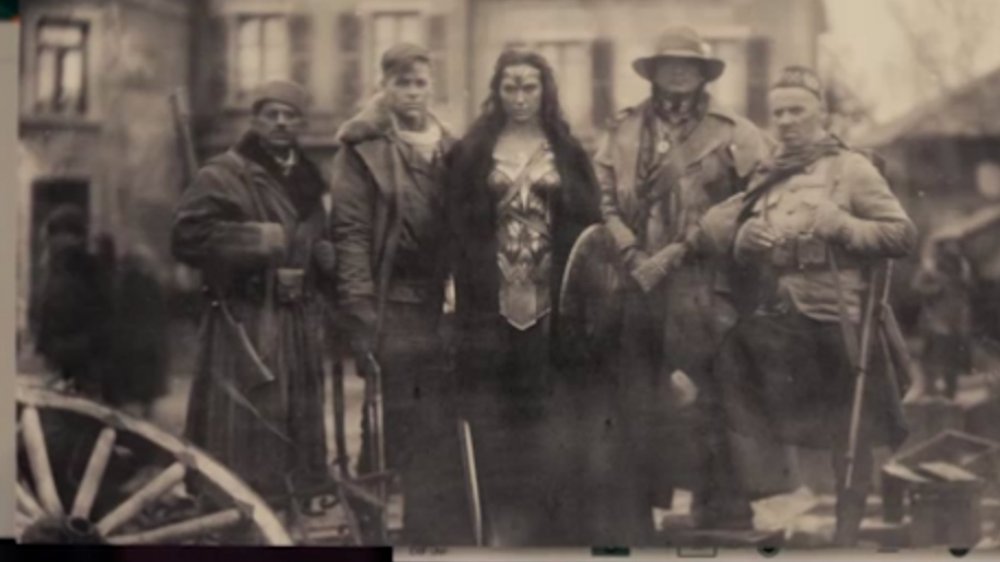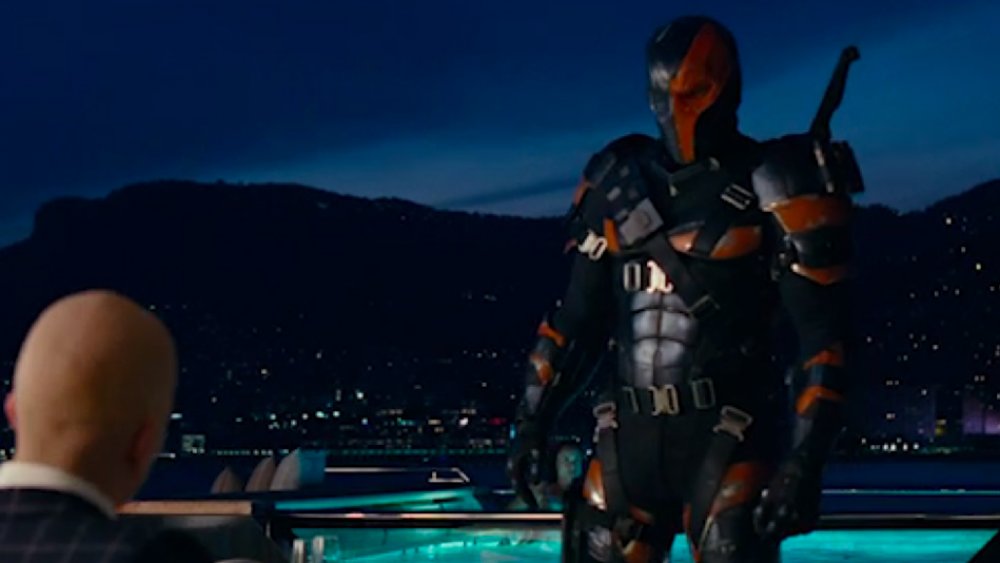Things DC Shows Are Doing Better Than The DCEU
The DC Universe has always been a little fragmented on the comics page, with fictional hometowns like Gotham and Metropolis that were built around a single character and a multiverse of infinite Earths that kept entire rosters separate from each other until a cosmic conflagration required them to team up. That said, the lines between the comics are nothing compared to the vast canyon that exists between the live-action versions of the characters. With the TV shows that sprung up out of Arrow and the movies that have been slowly building on the foundation of 2013's Man of Steel, we've got two separate takes on the DC Universe that have almost nothing to do with each other.
Obviously, the movies get the big budgets, the promotion, and the audiences that head into theaters to see what Superman and the rest of the Justice League are up to, but the shows that fill up the CW's weeknight lineup have a few advantages too. The question is, with all the extra time they have with an hour of TV every week, do they actually do things better than the films? We think so, and here's why.
Drawing from the source
Hey, did you know that all of these movies and TV shows are based on comic books? Yeah, they still make those. Crazy, right? But while both the DCEU movies and the TV shows draw on their four-color source material to inspire their stories, the shows seem a little more committed to capturing what people like about those characters on the page.
For the movies, most of the elements lifted from the comics are purely visual. Batman's bulky Superman-fightin' armor in Batman v Superman: Dawn of Justice, for instance, is taken straight out of the big fight scene at the climax of The Dark Knight Returns, and we were all at least a little bit surprised when Jason Momoa turned up wearing Aquaman's classic orange and green costume at the end of that film. Aside from those visuals and a few isolated incidents, though, the story content of the DC films is pretty far removed from the comics they're drawing from, and honestly? That's not necessarily a bad thing. As the Watchmen movie proved, shooting for a straight one-for-one adaptation of a comic book into film can lead to some profoundly mediocre results, and as the Watchmen TV show proved, springing off of that foundation into something very different can lead to something truly great.
Unfortunately, the DC movies don't tend to be that great at building on those foundations. Making Doomsday the product of some weird Kryptonian blood magic that's empowered by the god-science of the Fourth World is actually way better than his comic book origin of being a bone monster in bike shorts that shows up one day to punch Superman to death, but that's about where their success rate ends.
The shows, meanwhile, have proven to be extremely adept at translating that comic book inspiration into a different medium. Supergirl's take on Alan Moore and Dave Gibbons' "For The Man Who Has Everything," in which Superman is trapped in a hallucination of a flawed Krypton that never exploded, is about as strict an adaptation as you're likely to find, and it works very well. The TV version of Crisis on Infinite Earths might actually be the best example, keeping the core idea, imagery, and spirit of the original story without getting bogged down in its considerable flaws while also making changes that fit the new medium. The shows are full of homages, adaptations, and direct lifts from DC's long comic book history, which makes them feel connected to the source in a way that the movies simply aren't.
DC Deep Cuts
To their credit, the DC movies have actually done a pretty decent job of digging into the past 80 years of comic books to come up to find some obscure characters to dust off and give new life. Wonder Woman features Doctor Poison as a major villain, and she's not even the second most famous Wonder Woman villain whose first name is "Doctor." Batman v Superman dusted off the KGBeast, if only in name, to be Lex Luthor's chief henchmen, and even the most die-hard Aquaman fans probably never expected to see Topo the Octopus playing drums in a big-screen cameo.
The longer those movies go on, the more they dive into the deep cut characters that would've been considered too weird, goofy, or silly in a world before Rocket Raccoon and his friend, a tree, were some of the most popular characters in a billion-dollar franchise. They've got a long way to go if they want to catch up with the shows, though. Seriously: there are deep cuts, and then there's putting Wild Dog from the comic book Wild Dog in multiple seasons of a television show.
The CW shows have embraced all that DC Comics has to offer in a way that the movies simply haven't, and Wild Dog, who starred in a four-issue miniseries 33 years ago and hasn't headlined a comic book since, is just the tip of the obscure iceberg. Flash in particular has gone digging for villains, but you'd expect the bad guys to get pretty esoteric since there's one in every episode. What you wouldn't expect is seeing, say, Jemm, Son of Saturn, the Human Target, Dr. Mid-Nite II, and the B'Wana Beast. Flash even included Gorilla Grodd, and while he's not exactly an obscure character — he's one of the Flash's more long-tenured and prominent villains — he is a telepathic super-gorilla from a city of telepathic super-gorillas, and after ten seasons of Smallville, we never expected to get that on TV.
Barry v Barry: Barry of Barry
While we're on the subject of the Flash, let's just go ahead and get it all out in the open: the movie version of Barry Allen flat-out sucks.
Admittedly, TV's Barry isn't exactly great. He's a square who spent an entire season moping around about having to bear the terrible burden of being a beloved superhero, completely wrecked the timeline, created a murderous doppelgänger of himself, and is always late for work. Also, while they wound up making a pretty good couple, it was really weird for the show to give us a lead character who had a crush on a lady who was essentially his stepsister. Really, though, the worst you can say about Barry in terms of personality is that he's a little bit of a dweeb.
Movie Barry, on the other hand, is a coward who has to be convinced to help people, and despite allegedly being a scientist, he doesn't really seem that bright. That's a shame, too, because as an actor, Ezra Miller absolutely has the charisma to pull off a character with the same kind of dorky likability that we see with Grant Gustin on TV. Ironically, that's only really evident in the scene where the two versions of the Flash meet each other during "Crisis on Infinite Earths." Maybe that'll change when the Flash finally gets a solo film in 2022 — which Miller is reportedly writing alongside former Flash and JLA writer Grant Morrison — but so far, the flash of the DCEU has all of the worst parts of Barry Allen and none of the redeeming qualities that we've seen elsewhere.
Not so super, man
Along the same lines, the DC television shows have also done a much better job with the guy who should be the most important character in the films: Superman. That's especially impressive when you consider that while he's got one in the works, the CW's Superman doesn't even have his own show.
While it boasted the most impressive action scenes ever seen in a Superman film, 2013's Man of Steel didn't exactly do Clark Kent any favors. In fact, "Clark Kent" was hardly in it, with Superman's mild-mannered alter ego, an aspect that's central to the humanity at the heart of his character, put on the shelf in favor of ham-handed Christ imagery. He's a version of Superman whose exploits are defined by failure — he fails to stop Metropolis from being destroyed in his fight with Zod, he fails to stop Luthor from blowing up Congress even though he's standing right there, he fails to defeat Doomsday. He even fails at staying dead, although that one ultimately works out for the best.
Once again, the most frustrating thing about all this is that Henry Cavill has the potential to be one of the best versions of the character ever put on film. The woefully under-appreciated Man From U.N.C.L.E. showed how effortlessly charming he could be while playing a character whose decency didn't dull his edge. Hell, The Witcher showed that Cavill could pull off a grumpy, unstoppably strong, weirdly alien hero, and Geralt of Rivia still came off as more interesting and likable than Superman. Despite his relative lack of time in the spotlight, the version of Superman Tyler Hoechlin plays on Supergirl is a much more heroic version of the character. He's the Superman who shakes hands with everyone at the DEO after he lands. He's a capital-letter Good Guy, and really: that oughta be what you want from Superman.
World-building
Translating what works about a superhero comic into a film is much more challenging than you might expect, for one simple reason: generally speaking, movies end. Even the ones that are part of a larger saga of sequels are meant to be a finite experience. Superhero comics, on the other hand, are meant to go on forever — or at least until sales drop — building their stories into a continuity that keeps readers coming back for more. That's one of the reasons that Marvel movies didn't really work that well until the MCU came along and started tying everything together into a sprawling monster of a franchise. The critics who complained that Endgame didn't make sense unless you'd seen 21 other movies before it were missing the point. That's a feature, not a bug.
Needless to say, TV shows are way more suited to that kind of storytelling, since they're another format that's told through chapters in a series that, if everything goes well, won't be ending any time soon. In that respect, the 14 seasons of Grey's Anatomy feel more like superhero comics than, say, Man of Steel, but there's an added side effect: even a single season of TV has at least six times more space to tell its story than your average superhero movie. That means that they have the space to do a whole lot more world-building.
For contrast, Batman v Superman is a movie with Batman in it where we never really get to see Gotham City, let alone explore what makes it an interesting and unique setting. Batman might as well have been the resident vigilante of Des Moines for all the character we get for the most famous setting in the entirety of the superhero genre. Just throw one gargoyle in there and we'll count it.
The DCEU has done bits and pieces of world-building here and there, but the movies just don't have time to make it matter. As a result, a lot of the world-building amounts to telling us that a ton of stuff happened — the supervillains in Suicide Squad being established as actual characters, origins for heroes like the Flash, the first 10 or 15 years of Batman's crimefighting career, little stuff like that. On top of that, they often take it for granted that you know about these characters from other media. Showing us that Robin is dead doesn't actually mean a whole lot if we never actually saw Robin while he was alive.
Crossover Crisis
One of the other big functions of having so much time to kill on a TV show, relatively speaking, is that it's a lot easier to weave characters and plots together when that stuff has already had the room to be established on its own. When you don't have to introduce the Flash, for example, you can spend that time developing his relationship to Supergirl when he shows up on her show. Or, if you're the DC shows, you can spend that time explaining things like interdimensional travel from Earth-1 to Earth-38 for turbo nerds like us.
As a result, the shows tend to pull off crossovers between characters in a much more entertaining fashion than the movies do. TV's "Crisis on Infinite Earths" shows exactly how this works. That thing would've essentially been a bladder-obliterating five-hour movie if it had been in theaters, but because its massive cast of characters have mostly been introduced elsewhere, it gets to fill up that runtime with the wild action and crowd-pleasing Easter eggs. There are arguably six main characters in that show, but they all have the space to bring them to a resolution.
Meanwhile, the movies have to make the choice between introducing characters or spending that time on literally anything else that goes into a story, like action, plot development, or building relationships. As a result, you get stuff like Suicide Squad, which introduces all the characters as briefly as possible through flashbacks where Amanda Waller tells us that they're all supervillains who fought the good guys in stories we've never seen, and it still feels like it takes too much time. The rest of the movie has to move super fast to balance it out, to the point where Diablo tells the rest of the Squad that they're like his new family after knowing them for about five minutes. Along the same lines, Batman v Superman tries to pave the way for Justice League with a brief introduction for Cyborg, Flash, and Aquaman that's literally just a bunch of files given to another character. Even if you can get past the idea that Lex Luthor apparently hired a graphic designer to make logos for all of his hated arch-nemeses, that's the very definition of telling, not showing.
Overarching plots
One of the biggest testaments to the strength of the CW's superhero lineup is that Legends of Tomorrow exists in spite of all the logic dictating that it shouldn't. It's a team with no name recognition — there was never a comic called Legends of Tomorrow before the show — made up of characters who were secondary at best on the shows where they started. Also, they had a season-long arc that ended with a Satan fighting a twelve-foot teddy bear. And yet, here we are, in a world where Legends not only exists, but has been successful enough to warrant multiple seasons.
Then again, throwing a bunch of characters who might not be strong or popular enough to stand on their own into a team that gets roped into crossovers fits right in with the traditions of superhero comics. They may be a mega-franchise now, but the Avengers, for instance, spent about 40 years as a book that might as well have been called The Adventures of Captain America's Friends. Either way, Legends has formed a connective tissue between all the other shows, allowing them to built complex overarching plots that drive the entire narrative forward. Like, say, ending eight years of a show about Green Arrow by having Oliver Queen become the Spectre, because they're both characters who wear green hoods and have zero other things in common.
What little overarching plot there is to the DC movies, however, barely feels connected to anything. The filmmakers clearly want there to be something connecting all these movies, and there is a tiny amount between BvS and Justice League in the form of the Mother Box, but none of that has anything to do with, say, Shazam. The things that do connect those movies don't feel like story elements as much as advertisements — the picture of Wonder Woman with all her World War I buddies doesn't tie into the big fight with Doomsday, it just lets you know that Wonder Woman exists. The overarching plot to unite the universe just isn't there. That isn't to say that whenever Aquaman's not on screen all the other characters should be asking "where's Aquaman?," although honestly, it couldn't hurt if they did that in the next Suicide Squad movie for giggles.
Villains
As the old saying goes, a hero is only as interesting as their villains, and traditionally, the movies based on DC Comics have understood that pretty well. It's one of the reasons Zod keeps coming back, because seeing what Superman would be like if he really was the conquering alien that Lex Luthor claims he is makes for an inherently interesting story. It's one of the reasons there have been so many screen versions of the Joker, with each one built in a completely different and pretty compelling way. Say what you will, he's a well-crafted bad guy who's at the heart of some of the best Batman stories.
The TV shows have done a solid job of building their villains. The biggest problem on that front is that, like the comics they're based on, the shows tend to fall into the standard "villain of the week" pattern that you get with a lot of action shows. Even within those confines, though, they've been able to do interesting stuff with the larger villains who loom over entire seasons. On Flash, the Thinker absorbing the powers of all those weekly villains to become a bigger threat was an interesting spin on a tired formula. The question of whether her feelings of betrayal will drive Lena Luthor to embrace her family's villainous past is one of the most compelling character arcs on Supergirl. Even Damien Darhk, who basically just likes to be evil, had that one scene when he was casting evil magic spells in Victorian London while dancing to "Return of the Mack" to give him a little character.
The villains in the movies are, to put it charitably, a little less developed. The most egregious example is probably in Justice League, where the good guys fight Steppenwolf, Darkseid's most forgettable henchman, who just stomps around frowning at things and being vaguely evil about it. As for why they didn't just have Darkseid himself, your guess is as good as ours. Maybe they thought that having the Justice League united together for the first time in a movie to fight a villain people might have actually heard of would be a little too exciting. Also, remember how Deathstroke the Terminator is in that movie, played by professional Dungeons & Dragons enthusiast and Magic Mike XXL star Joe Manganiello? It's been years — and multiple movies — without anything even resembling a payoff for that.
